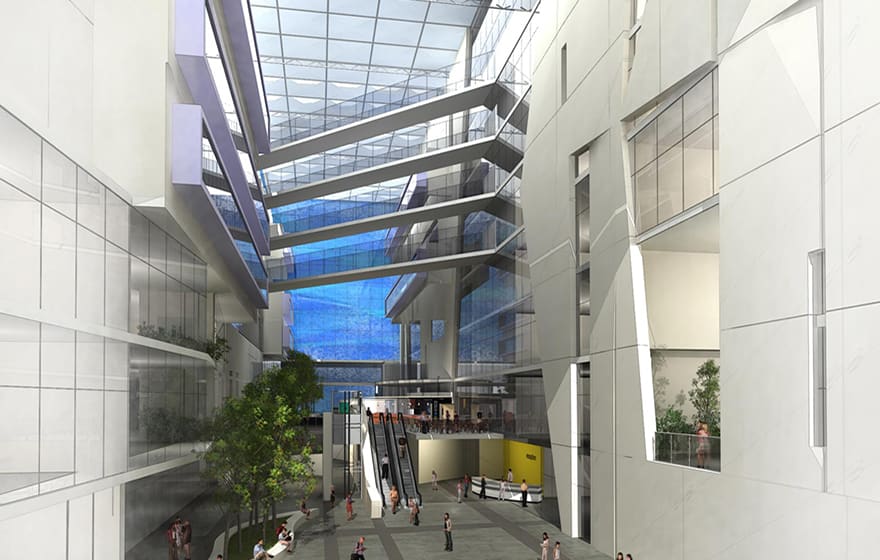
Suppliers navigate around the model, and can click on any room, component or equipment to view intelligent structured data about the design, and learn about the requirements of the project.– Steve Massey
Sandwell Metropolitan Borough Council has won awards for its pioneering West Midlands Virtual Hospital, a digital model of the £353m PFI Midland Metropolitan Hospital (MMH) for suppliers and subcontractors. Procurement manager Steve Massey explains the concept.
How does the West Midlands Virtual Hospital work?
The virtual hospital acts as a 3D ‘walk-through’ procurement directory. Suppliers navigate around the model, and can click on any room, component or equipment to view intelligent structured data about the design, and learn about the requirements of the project. They can then upload information about their products, designs, expertise, and so on, as well as their BIM capability. The main contractor, Carillion, will use this information to inform its procurement decisions.
Where did the inspiration for the virtual hospital come from?
My procurement background is in the automotive sector – I used to work for Rolls Royce – and that’s where the thinking comes from. We previously created a virtual car – the Black Country Bullet – and the principle was exactly the same as for the hospital: a virtual model of a car, accessible online, which allowed local firms to click on components they were interested in supplying and register details about their business and products.
How was the model created?
We tendered for a software provider to help us, and we were fortunate to find a very good local company called Virtechs, based in Cradley Heath, who guided us through the process. We also received a lot of support from contractors including Carillion, Interserve and Laing O’Rourke.
Carillion ‘donated’ elements of BIM models from other hospitals they had worked on – wards, operating theatres – including Southmead Hospital and Liverpool University Hospital. So the virtual hospital is a combination of BIM designs from other hospitals.
With Carillion now appointed as main contractor, the virtual model will evolve into the final design for the Midland Metropolitan, but the overall layout will not change much. WMVH has not cost the council a penny; we have raised £44,000 in sponsorship which has covered the budget.

What is the main aim of WMVH?
We see technology as an enabler of the local economy, and as a council, with a lot of buying power, we want to do as much as we can to help Black Country businesses develop their digital capability. MMH has been on the horizon for a while, and with BIM technology advancing rapidly, we saw it as a great opportunity to develop the skills of our local SMEs, and our own staff too. In the future, they will hopefully be able to take those skills and services around the UK and abroad.
Are you providing BIM training for local firms?
We hold free monthly BIM workshops for SMEs, which are facilitated by experts from BIM Academy, BIM Technologies and BIM Object, and attended by BIM specialists from Carillion and major suppliers such as Metsec, Unistrut, and Briggs Amasco.
We have also created a BIM resource suite at the council – a 12-workstation centre which will be used to train our own staff, incumbent suppliers, the NHS trust’s estate managers, Carillion’s category managers, and Carillion’s supply chain too. In the future, it will be charged out to businesses and other public sector organisations, as we want the centre to generate a revenue stream that makes it self-sufficient.
How sure can you be that local firms will be picked by Carillion?
There is a contractual agreement with Carillion to use WMVH, and we have functionality built into the virtual hospital which allows us to measure how many local firms they are using – the target is 80%.
Additionally, Carillion is committed to a supply chain engagement programme, which includes BIM training. On 8 October, we have a supplier event when the concept designs for the actual hospital will be unveiled, and suppliers who have registered with WMVH will get the opportunity to have 15-minute, one-to-one meetings with Carillion’s category managers.
Alex Lubbock, Carillion’s BIM development manager, will define the level of BIM capability he expects from suppliers. The event will be held at the same venue where we have our BIM suite.
How have local firms responded?
Over 600 companies have registered so far. Already, three firms have been appointed by Carillion for prelims work through WMVH: two civils firms, Forkers from West Bromwich and IWS from Tipton, and demolition contractor Coleman from Great Barr. We are hoping that the big local employers who are headquartered in Sandwell – Metsec, Hadley Group, Unistrut – will secure the major packages. As and when that happens, we will work with these firms to help them train their supply chain in BIM as well.

Do you see a future for the ‘virtual’ concept in other construction sectors?
Definitely. We have already talked to HS2 about creating a virtual station for Curzon Street, the terminus of the high-speed line in Birmingham. We have also discussed the idea with our other big construction suppliers Skanska, Vinci, Lovell, Interserve. The virtual model is scalable and could be used for a £10m job, not just projects costing hundreds of millions. We have created a white label business model to support the virtual concept, so it could easily be transferred to a project elsewhere.
Based on your previous experience, what can construction learn from other industries regarding digital modelling?
In the automotive sector, digital engineering is probably 10 years ahead of construction. In aerospace, Rolls Royce actually monitor the performance of their engines in aeroplanes when they’re in the air – pilots can communicate with engineers back in the factory. Construction is some way off that kind of intelligent approach to product development. At the moment, the biggest stumbling block with developing the industry’s digital capability is the supply chain; that’s why we have concentrated on getting them up to speed.
Comments
Comments are closed.
















I really can’t wait to see it all happen, alas I will be retired by then. My main and only criticism is the communication to the work-face as all the best BIM software and fly throughs you can create will not be available to the man with the screw driver or trowel. Yes the construction industry is 10 or even 15 years behind the automotive industry, the construction industry employs the majority of low skilled labour. Especially in the Middle East so my thoughts are it would be nice to have, do we have the people who can follow it down the line? That is another question. The construction industry will need to be dragged screaming into the future, as there is so much opposition and lack of knowledge at present. I believe only legislation will compel construction company’s to comply and buy in to the new technology. The clients will like it. I do like the fact you say the ‘….WMVH has not cost the council a penny; we have raised £44,000 in sponsorship which has covered the budget….’ now that is the way forward well done.